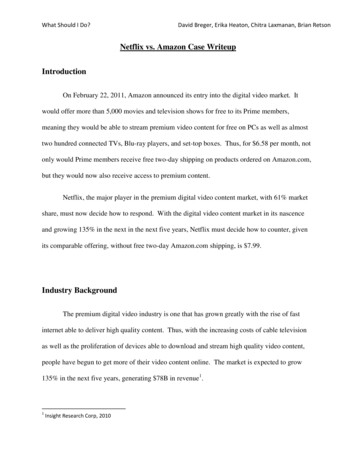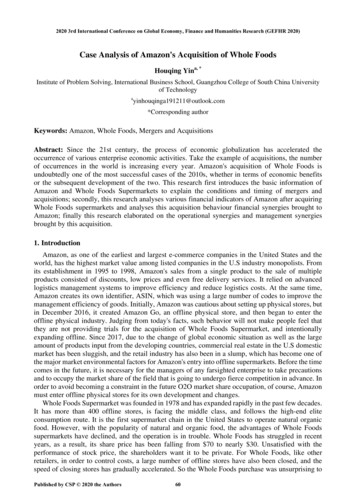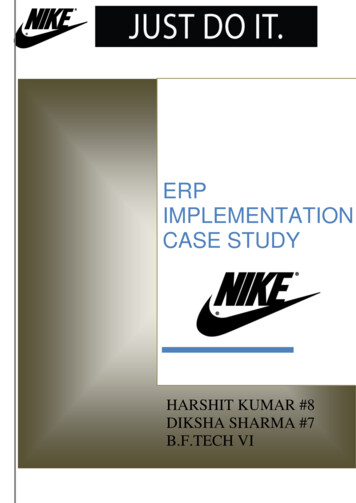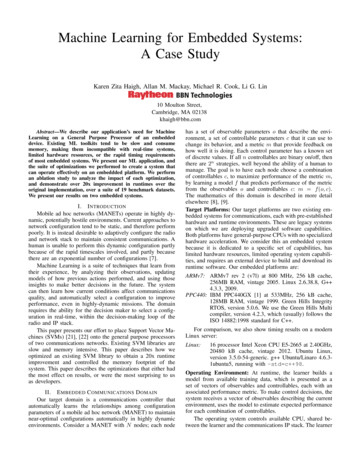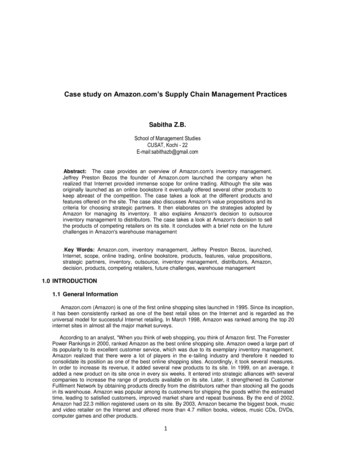
Transcription
Case study on Amazon.com’s Supply Chain Management PracticesSabitha Z.B.School of Management StudiesCUSAT, Kochi - 22E-mail:sabithazb@gmail.comAbstract: The case provides an overview of Amazon.com's inventory management.Jeffrey Preston Bezos the founder of Amazon.com launched the company when herealized that Internet provided immense scope for online trading. Although the site wasoriginally launched as an online bookstore it eventually offered several other products tokeep abreast of the competition. The case takes a look at the different products andfeatures offered on the site. The case also discusses Amazon's value propositions and itscriteria for choosing strategic partners. It then elaborates on the strategies adopted byAmazon for managing its inventory. It also explains Amazon's decision to outsourceinventory management to distributors. The case takes a look at Amazon's decision to sellthe products of competing retailers on its site. It concludes with a brief note on the futurechallenges in Amazon's warehouse management.Key Words: Amazon.com, inventory management, Jeffrey Preston Bezos, launched,Internet, scope, online trading, online bookstore, products, features, value propositions,strategic partners, inventory, outsource, inventory management, distributors, Amazon,decision, products, competing retailers, future challenges, warehouse management1.0 INTRODUCTION1.1 General InformationAmazon.com (Amazon) is one of the first online shopping sites launched in 1995. Since its inception,it has been consistently ranked as one of the best retail sites on the Internet and is regarded as theuniversal model for successful Internet retailing. In March 1998, Amazon was ranked among the top 20internet sites in almost all the major market surveys.According to an analyst, "When you think of web shopping, you think of Amazon first. The ForresterPower Rankings in 2000, ranked Amazon as the best online shopping site. Amazon owed a large part ofits popularity to its excellent customer service, which was due to its exemplary inventory management.Amazon realized that there were a lot of players in the e-tailing industry and therefore it needed toconsolidate its position as one of the best online shopping sites. Accordingly, it took several measures.In order to increase its revenue, it added several new products to its site. In 1999, on an average, itadded a new product on its site once in every six weeks. It entered into strategic alliances with severalcompanies to increase the range of products available on its site. Later, it strengthened its CustomerFulfilment Network by obtaining products directly from the distributors rather than stocking all the goodsin its warehouse. Amazon was popular among its customers for shipping the goods within the estimatedtime, leading to satisfied customers, improved market share and repeat business. By the end of 2002,Amazon had 22.3 million registered users on its site. By 2003, Amazon became the biggest book, musicand video retailer on the Internet and offered more than 4.7 million books, videos, music CDs, DVDs,computer games and other products.1
Further, Amazon had the distinction of being the first e-commerce site to use collaborative filtering5technology . Amazon's immediate business goal was to 'get big fast' which reflected the driving forcebehind the company's growth.2.0. BACKGROUND NOTE''The logistics of distribution are the iceberg below the waterline of online bookselling,'' Jeff Bezos,founder and chief executive of Amazon.comThe Internet has changed the way that we perceive business and the way that we as consumers maymake our purchases. In fact, the online consumer today knows the convenience of purchasing a bookonline and having it delivered to their door in a matter of a few days. There is no more need to fightcrowds, find a parking spot, and deal with traffic. The high street and mail order systems still have aplace in the mix of purchase routes; however it is no longer the only method of making purchases. TheInternet revolution has seen a massive increase in the long distance purchases made by consumers, asgeographical barriers are no longer as important as they were. The lack of geographical importance hasinfluenced the strategy of Internet companies. One of the first companies that took advantage of thiswas the online bookshop Amazon.com.The case provides an overview of Amazon.com's inventory management. Jeffrey Preston Bezos thefounder of Amazon.com launched the company when he realized that Internet provided immense scopefor online trading. Although the site was originally launched as an online bookstore it eventually offeredseveral other products to keep abreast of the competition. The case takes a look at the differentproducts and features offered on the site. The case also discusses Amazon's value propositions and itscriteria for choosing strategic partners. It then elaborates on the strategies adopted by Amazon formanaging its inventory. It also explains Amazon's decision to outsource inventory management todistributors. The case takes a look at Amazon's decision to sell the products of competing retailers on itssite. It concludes with a brief note on the future challenges in Amazon's warehouse management.The continued success of Amazon.com can be attributed to its diversity in terms of geography as wellas its diverse selection of merchandise, ranging from media such as books, CD's, and videos to onlineauctions and house wares. Amazon.com currently operates four international websites in France,Britain, Germany and Japan giving it global Internet exposure. One of several factors that have provenAmazon.com successful is that it has the first mover advantage. Not only was it first in its industry, ithas also been successfully marketed. But as with any Internet site, the actual presentation andprocessing are seen as a result of the underlying technology and the way the company uses it.3.0 VALUE PROPOSITIONAmazon built a four-fold value proposition that indicated its priorities in the establishment of theonline venture. The four dimensions it focused on were convenience, selection, price, and customerservice. The online venture was convenient as it was open for business all the time. The site was sodesigned as to keep the download time at a minimum. The site also offered its users various facilitiessuch as reviews, e-mail notifications, reference from a previous search and product recommendations.It also provided the users with a wide range of product options, which they could select from. Amazonhad an inventory consisting of millions of items which was roughly about 100 times that of a typicalphysical store.4.0 STRATEGIC ALLIANCESIn order to expand in a rapid and a cost-effective manner, Amazon decided to partner with othercompanies. The main criterion used by Amazon for selecting a partner was the customer serviceprovided by the company. During 1998-2000, Amazon acquired ownership stakes ranging from 17 to 49percent in various online retailers- Greenlight.com, Living.com, Drugstore.com, HomeGrocer.com,Pets.com, Ashford.com, Gear.com, and Della.com. Amazon spent an estimated 160 million onacquiring stakes in these companies2
5.0 INVENTORY MANAGEMENTWhen Bezos started his venture, he aimed at hassle-free operations. He wanted to offer hiscustomers a wide selection of books, but did not want to spend time and money on opening stores andwarehouses and in dealing with the inventory. He however realized that the only way to satisfycustomers and at the same timer make sure that Amazon enjoyed the benefits of time and costefficiency was to maintain its own warehouse. Building warehouses and operating them was a verytough decision for Bezos. Each warehouse cost him around 50 million and in order to get the money,Amazon issued 2 billion as bonds. In 1999, Amazon added six warehouses in Fernley, Nevada;Coffeyville, Kansas; Campbellsville, Kentucky; Lexington, Kentucky; McDonough, Georgia; and GrandForks, North Dakota. On the whole, Amazon had ten warehouses. Most of these warehouses were setup in states with little or no sales taxWhen Bezos started his venture, he aimed at hassle free operations. He wanted to offer his customers awide selection of books, but did not want to spend time and money on opening stores and warehousesand in dealing with the inventory. He however realized that the only way to satisfy customers and at thesame time make sure that Amazon enjoyed the benefits of time and cost efficiency was to maintain itsown warehouse. Building warehouses and operating them was a very tough decision for Bezos. Eachwarehouse cost him around 50 million and in order to get the money, Amazon issued 2 billion asbonds. In 1999, Amazon added six warehouses in Fernley, Nevada, Coffeyville, Kansas, Campbellsville/Kentucky, Lexington, Kentucky, McDonough, Georgia and Grand Forks, North Dakota. On the wholeAmazon had ten warehouses. In the same year Amazon increased its worldwide warehousing capacityfrom 300,000 square feet to over five million square feet. Since Amazon ordered books and otherproducts from warehouses only after the customers had agreed to buy them the return rate was only0.25 percent compared to the return rate of 30 percent in many segments of the online retail industry.Amazon‟s warehouses which was a quarter-mile long yards wide stored millions of books, CDs, toys andhardware. They were very well maintained and completely computerized. In fact the number of lines ofcode used by Amazon‟s warehouses was the same as the number used by its website. Whenever acustomer placed an order a series of automated events followed which made inventory managementeasier.When a customer ordered a book from Amazon his invoice mentioned the title of the bookfollowed by a barcode. This was a code of numbers such as 6-5-4 which indicated the book‟s location inthe warehouse. Computers sent signals to the workers wireless receivers telling those items had to bepicked off the shelves. The workers decided the order in which the items had to be picked and thenverified the weight of each product.These products were kept in a green crate which contained orders of different customers, when this gotfilled they were placed on conveyor belt and sent to central point. Here the barcodes were matched withthe order numbers to find out who would receive each item. Then they were packed and parceled. Mostof the orders were shipped either through the United States postal service or United States parcelservice whichever is located nearer. In the holiday season of 1999, Amazon was determined not todisappoint any customer who visited its site for his holiday shopping. Accordingly Bezos decided to stockthe stores with every possible item that customers were likely to buy. Although this strategy wasappreciated‟ but Bezos faced a lot of problems.It was then Bezos realized the importance of Inventory Management and decided to reduce the size ofinventories, this was made possible by managing the warehouses efficiently. Amazon made carefuldecisions about which products to buy from where. Then the company decided to manage distributingchannels. An important decision was taken was buying of books, CDs videos etc. directly frompublishers rather than from distributors. They upgraded the software and also tried split shipments.Amazon also tried to cut down its expenses. It decided to outsource some of its routine activities so thatit could concentrate better on its core activities. It partnered with other companies for shipping theinventory. So, while the partners shipped the items, Amazon leveraged on its e-commerce expertise. Itrevamped the layout of its warehouses making it easier for the company to locate and sort customers. Bydoing this it managed to save all the expenses related to filling and shipping orders. Improved inventorymanagement helped Amazon to get net profit of 5 million in the fourth quarter of 2001 afteraccumulating a deficit of 2.86 billion in seven years since its launch in 1995.3
5.1 Inventory OutsourcingOutsourcing is subcontracting a service such as product design or manufacturing, to a third-partycompany. The decision to outsource is often made in the interest of lowering cost or making better use oftime and energy costs, redirecting or conserving energy directed at the competencies of a particularbusiness, or to make more efficient use of land, labor, capital, (information) technology and resources.Outsourcing became part of the business lexicon during the 1980s. It is essentially a division of labour.Outsourcing in the information technology field has two meanings. One is to commission thedevelopment of an application to another organization, usually a company that specializes in thedevelopment of this type of application. The other is to hire the services of another company to manageall or parts of the services that otherwise would be rendered by an IT unit of the organization. The latterconcept might not include development of new applications.5.2 Drop shipment modelDrop shipping is a supply chain management technique in which the retailer does not keep goods instock, but instead transfers customer orders and shipment details to either the manufacturer or awholesaler, who then ships the goods directly to the customer. As in all retail businesses, the retailersmake their profit on the difference between the wholesale and retail price.In 2001 Amazon decided tooutsource its inventory though it knew that it was a huge risk. When Amazon managed its own inventoryit had earned the reputation of providing superior customer service, which was its biggest strength.Amazon did not stock every offered on its site. It stocked only those items that were popular andfrequently purchased. If a book that is not so popular is ordered Amazon requested that item from itsdistributor who then shipped it to the company. In the company, the items the items were unpacked andthen shipped to the respective custom
Case study on Amazon.com’s Supply Chain Management Practices Sabitha Z.B. School of Management Studies CUSAT, Kochi - 22 E-mail:sabithazb@gmail.com Abstract: The case provides an overview of Amazon.com's inventory management. Jeffrey Preston Bezos the founder of Amazon.com launched the company when he
